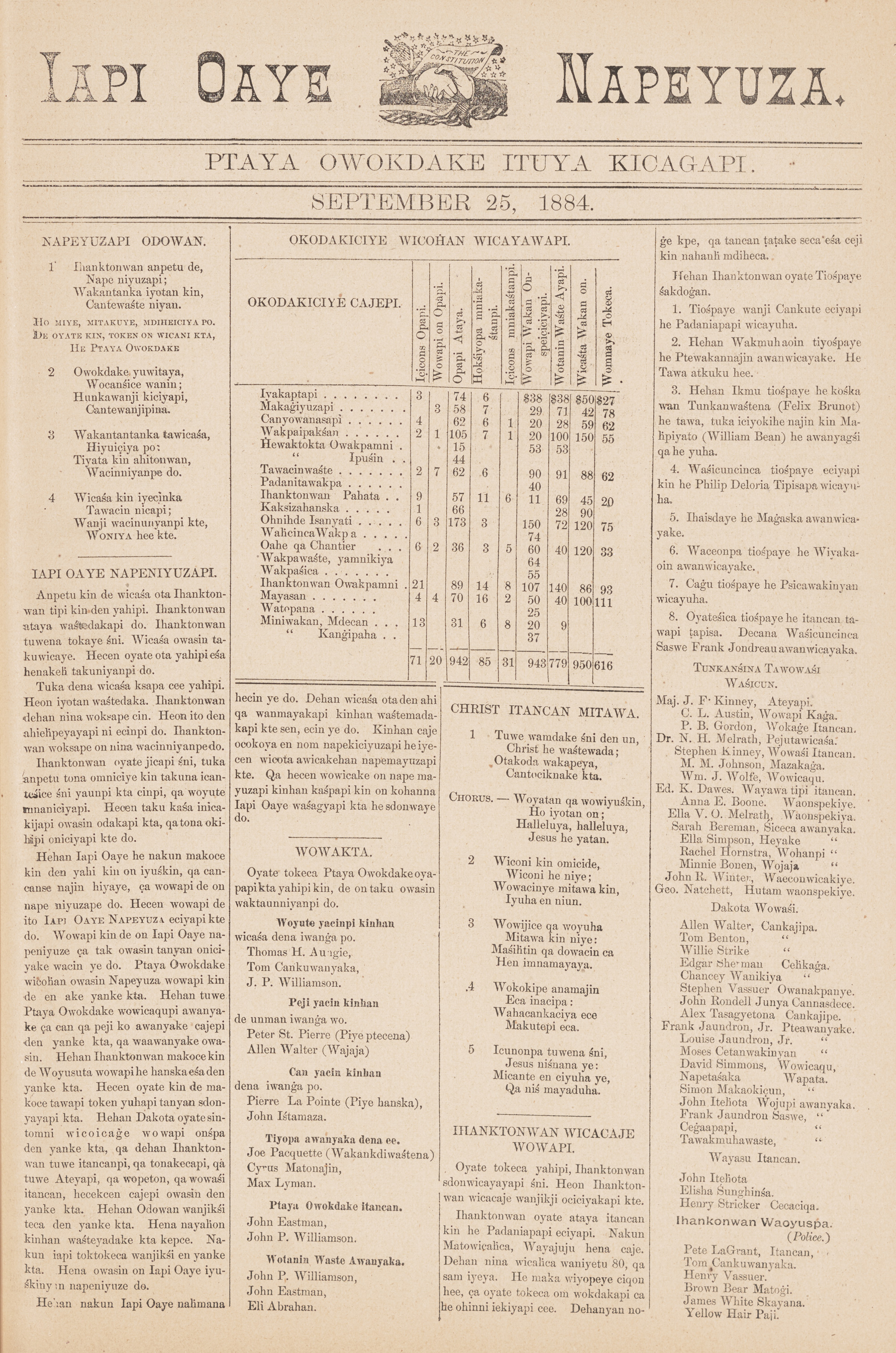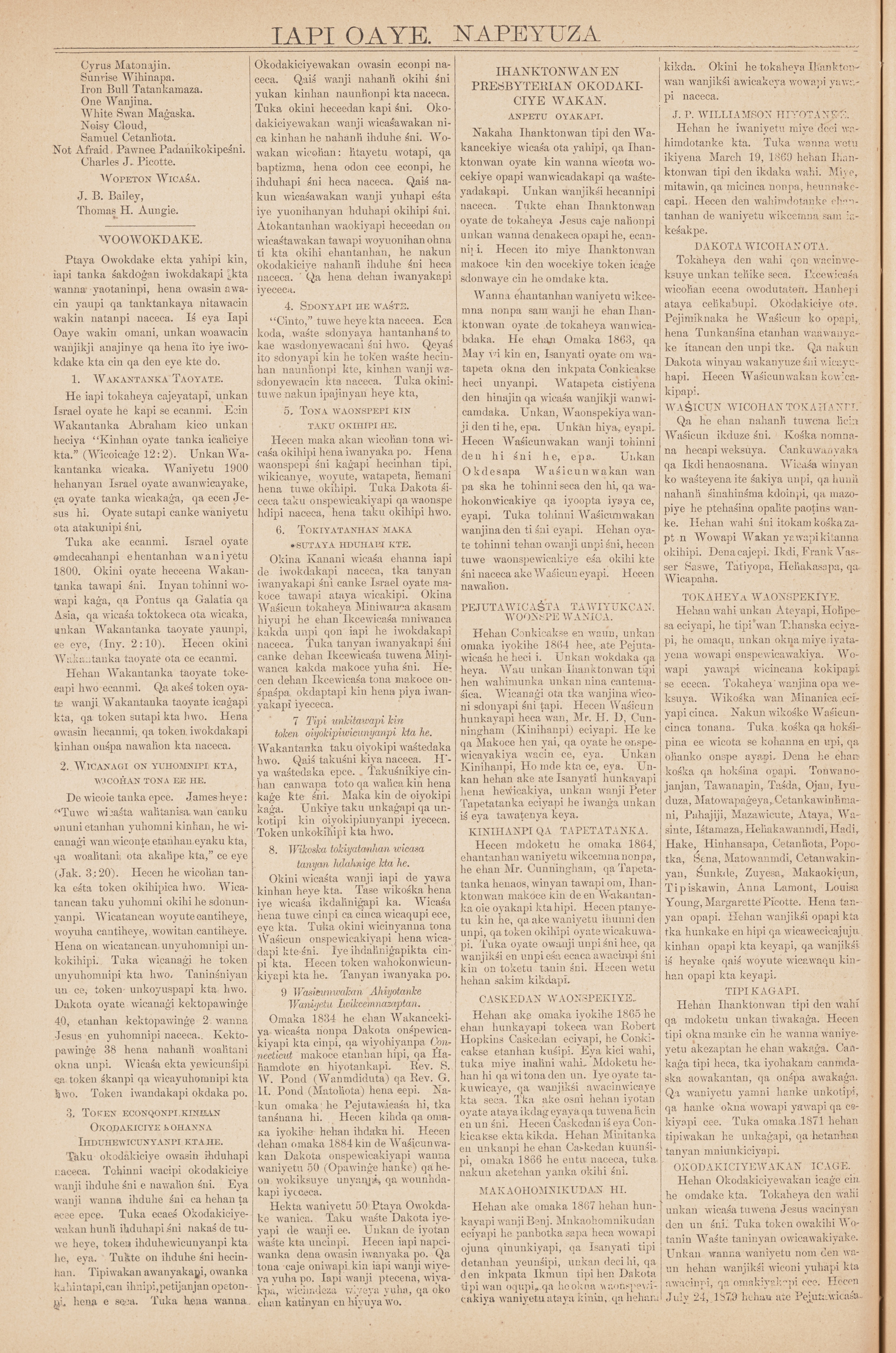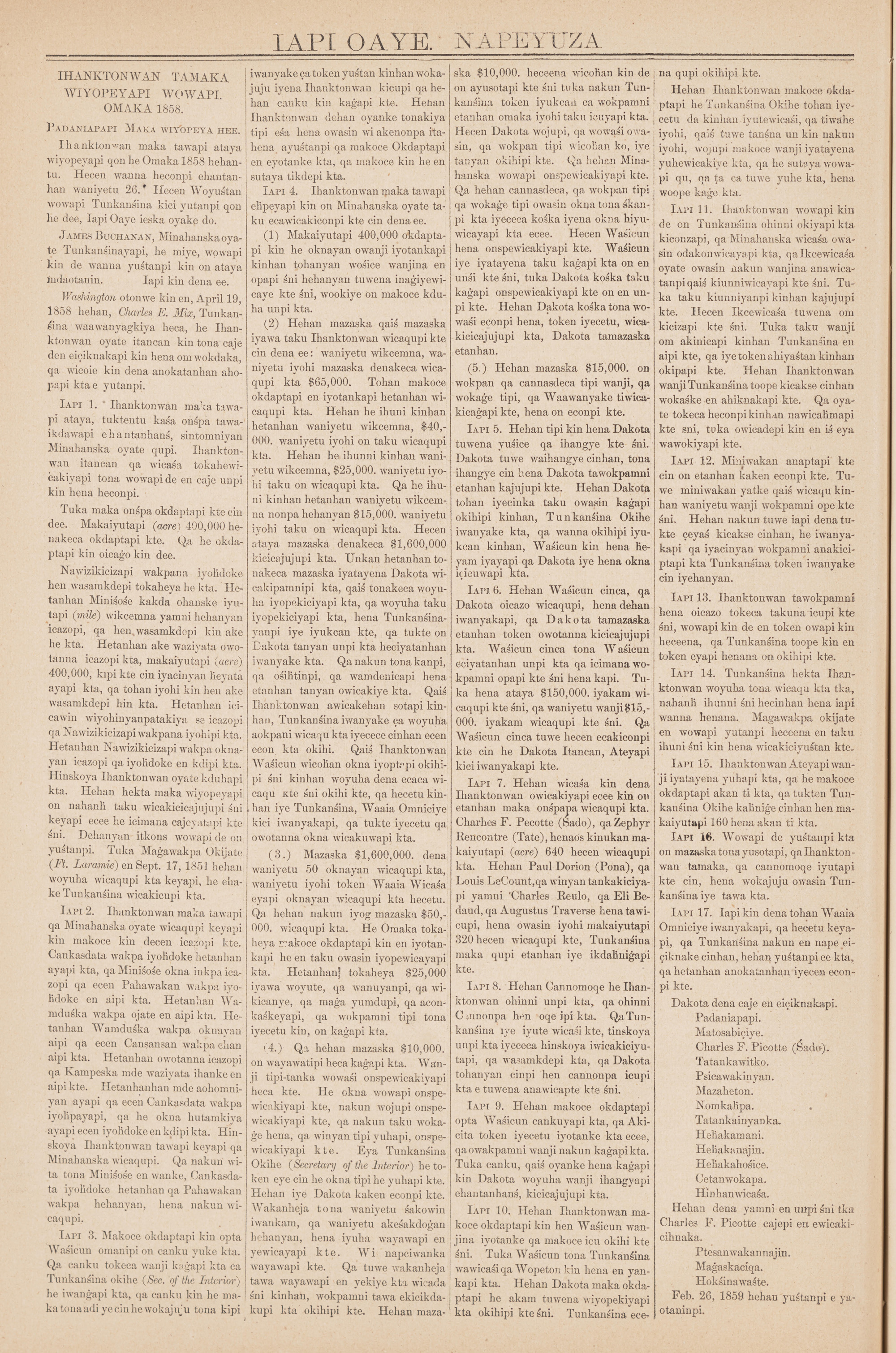Context
Let’s begin with the paper’s title and sub-heading, and how we might situate our analysis of this document within the complicated historical context out of which it was initially printed and circulated. Iapi Oaye Napeyuza can be translated as "language (or even literally as speaking) carrier" shaking your hand. Unlike both "Iapi Oaye" and "The Word Carrier," which both cost fifty cents, the sub-heading notes that this publication is “ituya” which means free, without cost, even gratuitous. An image situated between “Iapi Oaye” and “Napeyuza” shows two hands shaking with the words “The Constitution” (in English) on a document behind them, with stars in the background. Further study is needed to completely unpack the symbolism of this stamped image, but as a potential logo for this periodical it suggests overt links to American nation-building efforts and patriotic sentiment. It might also refer to the last page of the paper, which includes details from the 1858 Treaty between the Yankton people and the U.S. Government, which ceded 11 million acres of their homelands. Perhaps this paper was an attempt to further solidify the idea that Dakota people were articulating how to consider themselves as citizens of the United States while remaining members of the "Oyate," the Dakota nation? As such, they would be more likely to not only learn English and adopt aspects of American culture, but might have to accept new policies like allotment, which sought to break-up the collectively held lands of the Dakota and Lakota people and section them off into smaller family-owned parcels. The date of this paper, with its reference to the 1858 Treaty, seems to have foreshadowed allotment, which would begin just three years later with the General Allotment Act of 1887.
Historical moment
Although officially recognized as federal policy once approved by Congress in 1887, allotment had been practiced on a limited basis since the early decades of the nineteenth century, as eligible individuals on a reservation were issued a quarter section of land. Once this land was alloted the occupant was encouraged to adopt an agricultural way of living, an education in English language and culture, and eventually induced to give up any traces of their Indigenous ways of living. The 1858 Treaty signed by the Yanktonai like the Treaty of 1867 signed by other Dakota people, like the Sisseton and Wahpeton, were the beginning of this process. These treaties helped to establish some of the first reservations in the Dakota Territory, which would later be broken down into smaller, individually held, parcels of land. Throughout the 1880s and into the early twentieth century, allotment led to individual and fractional ownership by Native "heads of household" while simultaneously opening up “unallotted or unclaimed” lands to white settlers, thereby decreasing the total amount of land occupied by Native people. Historians of this time period have found that many of the allotments given to Native people were not the most fertile lands or the best for timber, whereas the neighboring parcels sold to white settlers and land speculators proved to be more profitable, and if not, were easily abandoned for greener pastures to the west. This history is important because this is the political and cultural context in which Iapi Oaye Napeyuza was published and circulated. Certainly the Dakota readers of this newspaper knew about this history firstand.
Audience
Dakota readers of Iapi Oaye Napeyuza, like the longer-running Iapi Oaye, were likely to encounter choices and pressures regarding whether or not they would accept the terms of a treaty, take up an allotment for farming, and submit to or resist sending their young children to an American school. White christian missionaries living amongst the Dakota, those who owned and operated the printing presses out of which these papers came, were there to teach about religion as much as encourage their Native neighbors to embrace these other aspects of assimilation into American society. It is curious then that these same missionaries worked with Dakota people to continue printing Iapi Oaye in the Dakota language both during and after the allotment and assimilation era. The articles in Iapi Oaye Napeyuza use language and forms of address that highlight the colonial context out of which this paper emerged.
Analysis
“Iapi Oaye Napeyuza” roughly translates as the “Handshake of Language Progress.” Dakota speakers today often use “Napeyuza” as a greeting, so we can also interpret the paper’s title as: “A greeting in the language.” Some initial analysis of the opening paragraphs in the first article from this issue reveal that the language being used speaks both for and to a Yankton audience. It describes the people as “waking up” and “more aware.” It also references relationality, a core value within Dakota society, by emphasizing how “All people take them [the Yanktonai] as relatives.” The paper goes on to describe the people, the Yanktonai, as smart, and willing to learn, as they “have accumulated a lot of wisdom.” But still, they [the Yanktonai] are not wealthy, but struggling and in need of food. These remarks refer to the consequences of colonization but also some possibilities for a better future.
The paper goes on to say: “they have suffered, and they will be able to tell their story, and will be able to breathe free.” The paper’s messages, forms of address, speaking for itself in the Yankton language, suggest a regionally specific audience and a desire to uplift them by telling their story using their own language, which in turn may be understood as an act of survival and resistance. The way the paper speaks for and to the people helps to convey the centrality of verbs within the Dakota language. Thus, it states that “Iapi Oaye” is happy that the land is “awakening” and “this paper greets all of you.”
What is more, the paper casually mentions another periodical, named: Ptaya Owokdake, which translates as “Together We Tell Our Story,” as an inspiration and model. Such a mention suggests a reading audience well-aware of Ptaya Owokdake, or at least a desire for one, on the part of Napeyuza’s publishers. What is important about this discovery regarding Dakota history, is that Iapi Oaye, and the Napeyuza issue along with Ptaya Owokdake point us to new archives of Indigenous language use and the emergence of an expanding print network at the very moment that colonial institutions and polices were aiming to limit Native power, over their land and their culture.
So, what more is revealed by these initial translations from the Napeyuza issue? Let’s consider this translation: “Yankton land will have this paper as firm record. This way, this people will be well aware of how they got their land. This will go around to all the Dakota people, so they will know who are the leaders of the Ihankthunwan nowadays, and they will know all the important names. We think you will enjoy this. It will bring the language together. Iapi Oaye is pleased to announce this to you.” So, here again, the paper speaks to and for the people and confirms its role, its way of acting, as a record and example of survival and resistance. The use of language in particular is critical to the role that the paper wants to play in offering a "firm record" of Yankton peoples' experiences of westward expansion as the US nation seeks to limit the type and amount of land that is occupied by Indigenous people.
Napeyuza here is meant to function as a vehicle for storytelling that will circulate widely enough so that all the Dakota people will know it and the language. Given that allotment policy would soon divide up tribally held and collectively owned land, this paper’s desire to speak to all the Dakota people and to affirm how the people have their land, predicts some of the fracturing that is to come.
The introductory article from the first page of the paper concludes with this powerful statement: “Soon, the name [Iapi Oaye Napeyuza] will be uttered among many people, and in the meanwhile, it will surely be growing.” This claim and the contents of this issue, along with the language used, we contend, was meant as an act of resistance. The desire that the name of the paper will be “uttered among many people” further urges for wider distribution, so that this publication can circulate to as many audiences, Native and not, as possible. Given the details from the 1858 Treaty printed on the last page of the paper, which includes the names of the signers, the desire for circulation seems intent on making sure that all Dakota people understand what the Yantonai have sacrificed. Thus, this issue’s overall message provides a warning and signals a concern about the breaking up of the larger Dakota “Oyate”-a word that refers both to the people and the Nation, which makes the references to taking everyone as their relative in the opening article all the more important. This brief example of a translation and some initial cultural and historical analysis opens up a new set of research questions concerning print history, Indigenous languages, and stories of survival. Working collaboratively, the tiošpaye for this project brings together Dakota linguistic experts and cultural knowledge keepers with historians and literary scholars to create new windows into the past. Looking through them we hope to reveal additional opportunities for language study and new avenues for historical research to benefit people today and for the generations to come.




